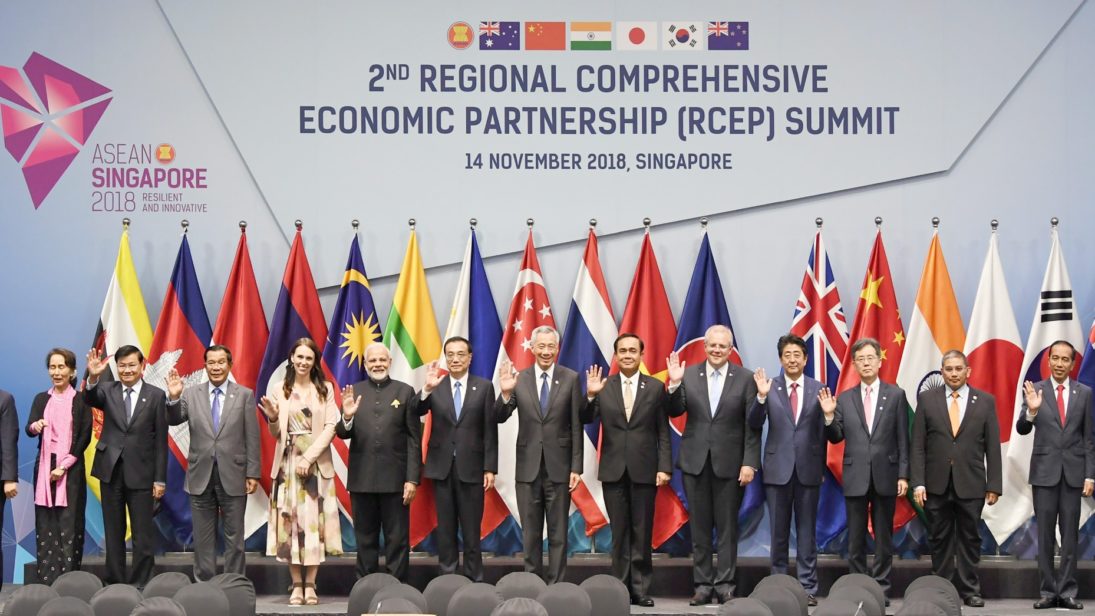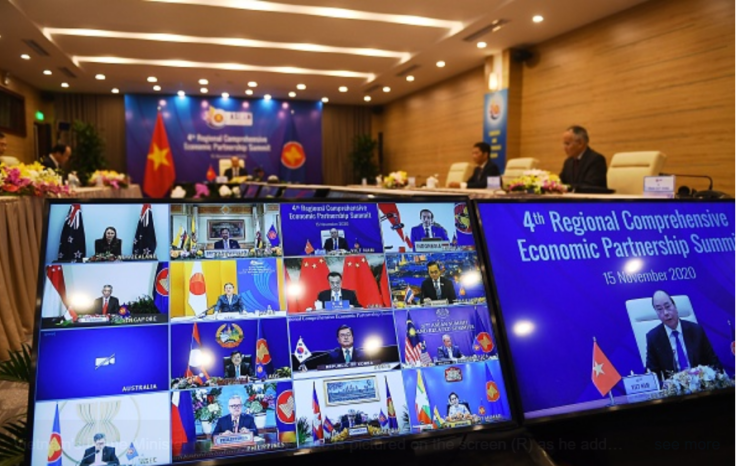
On November 15th, fifteen Asia-Pacific countries signed the Regional Comprehensive Economic Partnership (RCEP), the world’s largest trading arrangement that has been viewed as a China-led alternative to the now obsolete, U.S.-led Comprehensive and Progressive Agreement for Trans-Pacific Partnership. India was among the initial negotiators for RCEP in 2012 but retreated in November of last year. Partly driven by domestic and partly strategic reasons, the decision disappointed many. Free trade enthusiasts viewed it as a “protectionist impulse” that would inhibit domestic players’ competitiveness without exposure to global competition. Strategic thinkers viewed the decision as an opportunity lost for New Delhi to assert its economic and political presence in East Asia. Others looked at India’s withdrawal purely from the China prism—noting the primacy of India’s concerns over trade deficits and geoeconomic vulnerabilities in terms of noncompetitive sectors.
Although primarily a trade pact, RCEP’s strategic subtext should not be obscured amidst economic analysis. As Indian foreign minister S. Jaishankar indicated, strategic and economic thinking cannot be separated. By staying out of RCEP—despite progressive economic thinking at home and insistence from friends in Tokyo and Canberra—New Delhi has underscored two strategic points: first, the future of all Asian multilateralism is contingent upon China’s territorial aggression. Second, instituting economic barriers can prove effective in countering geopolitical aggression if blended with diplomatic negotiations and military resistance. For the second to work, the first is necessary as a country’s economic maneuverability may be severely restricted by acceding to RCEP like multilateral arrangement.
Although primarily a trade pact, RCEP’s strategic subtext should not be obscured amidst economic analysis.
By raising economic bulwarks against Chinese firms and curtailing RCEP’s market size, New Delhi has set a template for others to follow against Beijing if subjected to aggression. From Bangladesh to Bhutan and Myanmar to Mongolia, all those who fear an intimidating neighbor in China, may learn from India’s response even if they cannot emulate it entirely. Such economic barriers come at their own costs including the inability to harness benefits of free trade, but it seems New Delhi is likely to use the bilateral free trade arrangement route with RCEP participants as an alternative. Even if there are less dividends from such an alternative strategy, India would want to maintain its economic maneuverability as a tool for defending sovereignty.
China’s Aggression and Trade
It is believed in liberal economics that “when goods cross borders, armies do not.” However, China’s recent aggression profile in its neighborhood contradicts this aphorism as it nearly overlaps Beijing’s top trading partners. In the East China Sea, Chinese vessels have incessantly forayed into the Japanese-administered waters of the Senkaku/Diaoyu Islands repeatedly since mid-April, setting a new record. To the south, Indonesia, Vietnam, and Malaysia are increasingly subject to “high-risk intimidation” in their waters, especially after mid-April. Further, in South Asia, in a violent face-off in the Himalayan range, India and China registered casualties for the first time in the last 45 years due to newer claims by Beijing, and have yet to resolve the standoff.
A commonality among all countries engaged in a territorial dispute with China is their burgeoning trade relationship with the PRC. The littoral neighbors facing sovereignty challenges in the South China Sea are mostly members of ASEAN, which overtook the European Union this year as China’s largest trading bloc. China-Japan bilateral trade stands at a little over USD $300 billion while China and India trade goods worth nearly USD $100 billion, with over two-thirds of the trade in favor of Beijing. Clearly, despite the predictions of liberal economists, Chinese goods and armies cross boundaries—on land and at sea—together.

Economic responses
China’s neighbors such as India would not want to accede markets and territories simultaneously if they can afford to erect economic barrages—such as preventing Chinese firms from benefitting their markets—hoping such measures would restrict Beijing’s territorial march. For Beijing, the dependence of a country on China for vital goods in large volume serves the same foreign policy purpose as its free flow of capital; the reliance on China increases the country’s vulnerability and limits the possibility of countermeasures. Thus, economic dynamics between politically tensed neighbors such as India and China should be read with a geopolitical lens, including Indian demurral to RCEP.
When contemplating any stand-off with China, Indian foreign and strategic policymakers are likely to have considered economic recourse along with potential military responses. For example, as early as 2017 the Modi administration expanded the purview of “enemy property” law to include joint ventures with Indian partners together with wholly-owned “enemy firms.” As a result, the Indian government can confiscate properties of any foreign firm (or a joint venture) whose country of origin has territorially aggressed against India, a step that was critically received in China.
Further, at the onset of the Ladakh standoff, New Delhi’s military response at curbing PLA troops was coupled with a formidable economic reaction intending to hurt Chinese state-led and private firms immediately. Some of the economic deterrents included a blockade on automatic FDI allowance from China, a ban on dozens of Chinese apps, canceling construction contracts, restricting Chinese firms from providing telecom equipment, and preventing China from participating in highway construction and commercial coal mining contracts.
As a signatory of RCEP, New Delhi’s policy choices against Chinese capital and firms would have been capped. For example, the Investor-State Dispute Settlement (ISDS) mechanism is a part of the deal that would allow investors to drag New Delhi to international tribunals. Wary of such an arrangement from its earlier experiences, India mooted a model bilateral investment treaty in 2015 that expects foreign firms to exhaust domestic legal options for five years. This legal maneuverability would have to be conceded as a part of RCEP. Moreover, any additional reliance on China for critical goods, components, or pharmaceutical ingredients due to newer trade arrangements can considerably reduce India’s leverage against its mighty neighbor.
Asian Multilateralism
India has retreated from RCEP permanently. Consequently, Japan’s enthusiasm wavered with the deal and it was in two minds until President Trump’s loss, after which Tokyo caved in. With China-Australia relations hitting “lowest ebb,” the anger and mistrust could spill over in trade relations as well. If tensions continue to simmer between Beijing, Canberra, and Tokyo, the overall optimism may taper off, and the entire project may succumb to geopolitical apprehensions or be pared down to a China-ASEAN trade arrangement. After all, the attraction of a European common market did not prevent Britain from exiting the European Union, suggesting that the force of political differences at times prevails.
When India joined RCEP negotiations in 2012—and became the second-biggest stakeholder in the Asian Infrastructure Investment Bank (AIIB) in 2014—it was in awe of Asian multilateralism and believed there was space for two, or perhaps more, in Asia. New Delhi’s later refusals for the Belt and Road Initiative and RCEP only show increasing disenchantment with that idea of Asian multilateralism.
When India joined RCEP negotiations in 2012—and became the second-biggest stakeholder in the Asian Infrastructure Investment Bank (AIIB) in 2014—it was in awe of Asian multilateralism and believed there was space for two, or perhaps more, in Asia. New Delhi’s later refusals for the Belt and Road Initiative and RCEP only show increasing disenchantment with that idea of Asian multilateralism. Unless the participating costs are known, the reluctance to join any China-led multilateral arrangement for a country is natural given Beijing’s assertive behavior.
No one knows for certain whether India’s stiff military response, the palpable anti-China sentiment across Indian metropolises, or the instant blackballing of Chinese firms by the Indian government deterred the PLA from a repeat of the Galwan clash at Ladakh. The Chinese Foreign Ministry has, however, expressed “serious concerns” about India’s economic measures. Free trade arrangements enhance the stakes of the participants in each other’s economic growth, and respect for sovereignty are their prelude. By staying out of RCEP, New Delhi has accentuated the need for respecting sovereignty, making Asian multilateralism contingent upon calm frontiers. It is time for Beijing to realize that if armies continue to cross frontiers, fewer and fewer goods will.
***
Image 1: Press Information Bureau, India via Wikimedia Commons
Image 2: Nhac Nguyen/AFP via Getty Images


